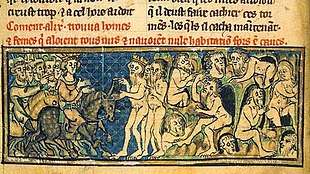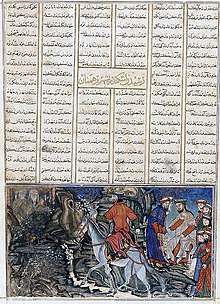Gymnosophists
Gymnosophists (Greek γυμνοσοφισταί, gymnosophistai, i.e. "naked philosophers" or "naked wise men")[1][2] is the name given by the Greeks to certain ancient Indian philosophers who pursued asceticism to the point of regarding food and clothing as detrimental to purity of thought. They were noted to have been vegetarian by several Greek authors.[2] There were also gymnosophists in upper Egypt who were called Ethiopean Gymnosophists by Apollonius of Tyana.[3][2]
In Greek literature they are mentioned in association with the Persian magi, the Chaldaeans of the Assyrians or the Babylonians, the druids of the Celts and the priests of Egypt etc. [4] Some sources claim that famous figures like Lycurgus, Democritus, and Pyrrho may have met them. They are mentioned by authors such as Philo, Lucian, Clement, Philostratus, and Heliodorus and are thought to have served as models to Cynics as well as Christian ascetics. Many authors have discussed the purported questions by Alexander and answers by the Gymnosophists.[5]

Ancient accounts
The term was used by Plutarch (c. CE 46 – CE 120) in the 1st century CE, when describing an encounter by Alexander the Great with ten gymnosophists near the banks of the Indus river in what is now Pakistan.
He (Alexander) captured ten of the Gymnosophists who had done most to get Sabbas to revolt, and had made the most trouble for the Macedonians. These philosophers were reputed to be clever and concise in answering questions, and Alexander therefore put difficult questions to them, declaring that he would put to death him who first made an incorrect answer, and then the rest, in an order determined in like manner; and he commanded one of them, the oldest, to be the judge in the contest. The first one, accordingly, being asked which, in his opinion, were more numerous, the living or the dead, said that the living were, since the dead no longer existed. The second, being asked whether the earth or the sea produced larger animals, said the earth did, since the sea was but a part of the earth. The third, being asked what animal was the most cunning, said: "That which up to this time man has not discovered." The fourth, when asked why he had induced Sabbas to revolt, replied: "Because I wished him either to live nobly or to die nobly." The fifth, being asked which, in his opinion, was older, day or night, replied: "Day, by one day"; and he added, upon the king expressing amazement, that hard questions must have hard answers. Passing on, then, to the sixth, Alexander asked how a man could be most loved; "If," said the philosopher, "he is most powerful, and yet does not inspire fear." Of the three remaining, he who was asked how one might become a god instead of man, replied: "By doing something which a man cannot do"; the one who was asked which was the stronger, life or death, answered: "Life, since it supports so many ills." And the last, asked how long it were well for a man to live, answered: "Until he does not regard death as better than life." So, then, turning to the judge, Alexander bade him give his opinion. The judge declared that they had answered one worse than another. "Well, then," said Alexander, "thou shalt die first for giving such a verdict." "That cannot be, O King," said the judge, "unless thou falsely saidst that thou wouldst put to death first him who answered worst." These philosophers, then, he dismissed with gifts...
— Plutarch, Life of Alexander, "The parallel lives", 64-65.[6]
Diogenes Laertius (fl. 3rd century AD) (ix. 61 and 63) refers to them, and reports that Pyrrho of Elis, the founder of pure scepticism, came under the influence of the Gymnosophists while travelling to India with Alexander, and on his return to Elis, imitated their habits of life; however, the extent of their influence is not described.
Strabo (64 or 63 BC – c. AD 24) says that gymnosophists were religious people among the Indians (XVI,I), and otherwise divides Indian philosophers into Brahmins and Śramaṇas (XV,I,59-60), following the accounts of Megasthenes. He further divides the Sramanas into "Hylobioi" (forest hermits, c.f. Aranyaka) and "Physicians."
Of the Sarmanes, the most honourable, he says, are the Hylobii, who live in the forests, and subsist on leaves and wild fruits: they are clothed with garments made of the bark of trees, and abstain from commerce with women and from wine.
— Strabo XV, I,60
Of the Sarmanes (...) second in honour to the Hylobii, are the physicians, for they apply philosophy to the study of the nature of man. They are of frugal habits, but do not live in the fields, and subsist upon rice and meal, which every one gives when asked, and receive them hospitably. (...) Both this and the other class of persons practise fortitude, as well in supporting active toil as in enduring suffering, so that they will continue a whole day in the same posture, without motion.
— Strabo XV, I,60
Philo Judaeus (c. 20 BCE – c. 50 CE), also called mentions the Gymnosophists twice in the course of listing foreign ascetics and philosophers who are, in his estimation, "prudent, and just, and virtuous" and therefore truly free:
And among the Indians there is the class of the gymnosophists, who, in addition to natural philosophy, take great pains in the study of moral science likewise, and thus make their whole existence a sort of lesson in virtue.
— Philo Judaeus, Every Good Man is Free, 74
But it is necessary for us...to bring forward as corroborative testimonies the lives of some particular good men who are the most undeniable evidences of freedom. Calanus was an Indian by birth, one of the gymnosophists; he, being looked upon as the man who was possessed of the greatest fortitude of all his contemporaries, and that too, not only by his own countrymen, but also by foreigners, which is the rarest of all things, was greatly admired by some kings of hostile countries, because he had combined virtuous actions with praiseworthy language.
— Philo Judaeus, Every Good Man is Free, 92-93.
In the 2nd century CE, the Christian theologian Clement of Alexandria distinguishes the Gymnosophists, the philosophers of the Indians, from the Sramanas, "the philosophers of the Bactrians":
Philosophy, then, with all its blessed advantages to man, flourished long ages ago among the barbarians, diffusing its light among the gentiles, and eventually penetrated into Greece. Its hierophants were the prophets among the Egyptians, the Chaldeans among the Assyrians, the Druids among the Galatians, the Sramanas of the Bactrians, and the philosophers of the Celts, the Magi among the Persians who announced beforehand the birth of the Saviour, being led by a star till they arrived in the land of Judaea, and among the Indians the Gymnosophists, and other philosophers of barbarous nations.
Classification
The Greek word gymnosophist literally meant 'naked sage' or 'naked sophist'.[2]
Indian
The Greeks encountered the gymnosophists in the third century BCE at the town of ancient Taxila in Ancient India, which was an ancient centre of Indian learning. The naked saints, whom Alexander met, are sometimes considered to be Digambara Jain monks, who have continued to practise nudity.[7][8][9] According to recent paper by Halkias, the gymnosophists could not have been Jains.[10]
One such noted gymnosophist was Calanus.[11][12] Before immolation, he is said to have prophesied the death of Alexander at Babylon.[13][14]
Another noted gymnosophist by Greeks was Dandamis, who was the teacher of Calanus. Alexander later learned Indian philosophy from him.[15]
| “ | For the polity of the Indians being distributed into many parts, there is one tribe among them of men divinely wise, whom the Greeks are accustomed to call Gymnosophists. But of these there are two sects, over one of which the Bramins preside, but over the other the Samanaeans. The race of the Bramins, however, receive divine wisdom of this kind by succession, in the same manner as the priesthood. But the Samanaeans are elected, and consist of those who wish to possess divine knowledge. | ” |
| — Porphyry, On Abstinence from Animal Food[16] | ||
The Brachmanes[2] or Bragmanes,[17] who are identified with Brahmanas of Vedic religion who remained unclothed, and whom even Porphyry (c. 234 – c. 305 AD) mentions having lived on milk and fruit, have been identified as gymnosophists.[2]
Similarly, the ancient Shramanas,[2] which included the Digambar sect of Jain monks, also remain unclothed. They too have been identified as gymnosophists by researchers.[2][18][19][20]
Ethiopian
The school of naked philosophers in upper Egypt was visited by the neopythagorean Apollonius of Tyana (c. 15 – c. 100 AD) who called them Ethiopian Gymnosophists.[2][17][21][22] Apollonius had met the Gymnosophists of India before his arrival in Egypt, and repeatedly compared the Ethiopian Gymnosophists with them. He regarded them to be derived from the Indians. They lived without any cottages nor houses, but had a shelter for the visitors. They did not wear any clothes and thus compared themselves to the Olympian athletes. They shared their vegetarian meal with him.
See also
Notes
References
- ↑ γυμνοσοφισταί. Liddell, Henry George; Scott, Robert; A Greek–English Lexicon at the Perseus Project
- 1 2 3 4 5 6 7 8 9 Quests of the Dragon and Bird Clan By Paul Kekai Manansala. 2006. p. 282.
- ↑ Apollonius of Tyana, SECTION X, THE GYMNOSOPHISTS OF UPPER EGYPT, by G.R.S. Mead, [1901,]
- ↑ The Gymnosophist Riddle Contest (Berol. P. 13044): A Cynic Text? Philip R. Bosman, 2010
- ↑ Alexander's Dialogue with Indian Philosophers. Riddle in Greek and Indian Tradition, A Szalc - Eos, 2011
- ↑ Life of Alexander, 64-65
- ↑ John Williams (1829). The Life and Actions of Alexander the Great. John Murray. p. 314.
- ↑ The Greeks in India: a survey in philosophical understanding. Demetrios Theodossios Vassiliades. 2000. pp. 46, 49.
- ↑ The Greeks in India:a survey in philosophical understanding, page 49
- ↑ Georgios T. Halkias “The Self-immolation of Kalanos and other Luminous Encounters among Greeks and Indian Buddhists in the Hellenistic world.” Journal of the Oxford Centre for Buddhist Studies, Vol. VIII, 2015: 163-186.
- ↑ Can the Subaltern Speak?: Reflections on the History of an Idea By Gayatri Chakravorty Spivak, Rosalind C. Morris
- ↑ A history of Hindu civilisation during British rule: Volume 1, 1894, page 72, Self-immolation is ancient practice of India called Maha-nirvana.
- ↑ History of Philosophy By Silvano Borruso. 2007. p. 50.
- ↑ My library My History Books on Google Play National Geographic , Volume 133. 1968. p. 64.
- ↑ The Legends of Alexander the Great By Richard Stoneman. 2012. pp. 43–44.
- ↑ Porphyry, On Abstinence from Animal Food Book 3. Section 17
- 1 2 Theios Sophistes: Essays on Flavius Philostratus' Vita Apollonii edited by Kristoffel Demoen, Danny Praet. 2009. p. 273.
- ↑ Jacquetta Hopkins Hawkes, The Atlas of Early Man, St. Martin's Press, 1993.
- ↑ Professor A.L. Basham, My Guruji, Sachindra Kumar Maity, 1997.
- ↑ Journal of the Royal Asiatic Society, Volume 6 By Royal Asiatic Society of Great Britain and Ireland. 1841. p. 384.
- ↑ Philostratus, Flavius (1809). The life of Apollonius of Tyana: Translated from the greek of Philostratus. Translated by Berwick, Edward. London. p. 322.
- ↑ Segovia, Fernando F.; Sugirtharajah, R. S., eds. (2009). A Postcolonial Commentary on the New Testament Writings. Sheffield: Sheffield University Press. p. 149. ISBN 978-0-567-63707-9.

